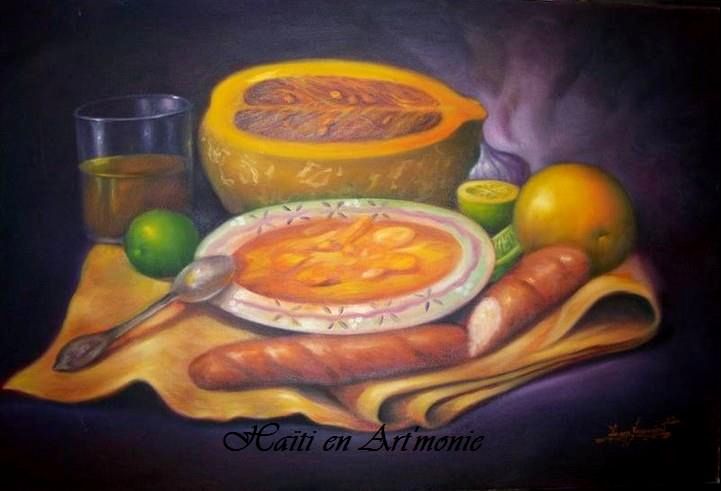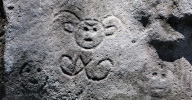Nwèl 2019 é joudlan
The First Soup Joumou
Doumafis Lafontan

Soup Joumou, Lucson Guerrier. Source: Haïti en armonie.
IntroductionThere is a tendency to compare Ayiti (e.g., Republic of Haiti) to other countries, particularly the United States (US). The comparison seems fair since Ayiti is the second independent country in the Western Hemisphere. Yet, Jean Price-Mars, author of Ainsi parla l’oncle, several years ago, concluded Haitians must not make any such comparison. Rather Price-Mars exhorted Haitians to find their intrinsic value. For Edouard Glissant, author of le discours Antillais, “It is not enough to choose the value, it must be defined.” It then follows, a local initiative comprised of observers on Ayiti decided to take a cursory review of the local Haitian economy to find the value of the Haitian fine arts. They posit the demand for Haitian fine arts at the local level will lift a significant segment of the population of Ayiti out of poverty. Historical legacy and traditionSaint Domingue, one year prior to the Independence of Ayiti, was the richest colony of France. The slaves were the secret of the overwhelming success of Saint Domingue, la perle des antilles. The number of slaves grew, from a little over five hundred thousand circa 1503, to millions in 1758. Hence the rebirth of Ayiti, which occurred on the battlefield at Vertieres, Cap-Haitien, Northern Region of Ayiti, conveys the epic story of Haitians. Nonetheless, it must be noted, the Haitian Revolution follows both the revolutions of 1776 in the US and that of 1789 in France. For Mbeki, ex-president of South Africa, it is as if the Haitian Revolution did not do as well as the other two revolutions previously mentioned. Unbeknown to Mbeki, Laroche, author of La literature Haitienne, pointed to the paradigm shift that the Haitian Revolution caused. “Even though it appears nothing changed. The violence changed camp. The Colonist paid for their crime” (Laroche, 1984). In the free communities, dèyè mòn gen mòn (mountain beyond mountain), thrived the confluence of the cultures of the Tayino, Awawak, and Ginen1. Once they realized the peril that the Colonist posed. They rallied the inhabitants of Ayiti, by pointing out the tragedy that would befall anyone who does not stand-up at this time of danger. From the days of Kawonabo, Anakawona, Padrejan, Makandal et al, the freedom fighters, who lived freely on the mountains beyond mountains, called, “Les marrons de la libérté” (Fouchard), constituted the main and real threat to the Colony. Indeed, these freedom fighters never put down their weapons, until the revolution succeeded. The social implication means, no other class of people will ever be able to enslave Haitians due to the fact that they won their freedom on the battlefield. Moreover, in 1825, Haitians paid fifty million Francs in gold to France for their Independence. A double debt, which Haitians scholars conclude, is the reason of the present day poverty that permeates in Ayiti, particularly in the urban areas of the major cities, such as Port-au-Prince the capital. This significant result having been achieved, the founders turned their attention to the Haitian Literature. The discourse of Dessalines, in Kreyòl, on January 1, 1804, formally opened the Oraliture2. Even though Tonnerre translated the words of Dessalines in French, the authenticity of this first text is beyond a shadow of a doubt. This diglossie, the domination of the French language over the Kreyòl that all Haitians speak, effectively ended with the new Constitution of 1987. Camille Chalmers et al, the president of the Plateforme Haitienne de Plaidoyer pour un Developpement Alternatif (PAPDA), maintains, “In this region, Ayiti enjoys comparative advantage in the arts”. Emile Nau, many years ago, wrote, “The artist will not succeed, unless he and/or she intertwines his and/or her art with the sentiment of the time. The Haitian artists must glorify the founders, farmers, and women of Ayiti in their works of art.” Today, it can be proposed, the National production of art, including craft, defies Maslow’s hierarchy of needs. For a country, like Ayiti, reputed to be the poorest in the Western Hemisphere, the fine arts appear everywhere. In spite of the number of paintings, and/or craft, produced, the majority of Haitians artists fit the profile of the poor Haitian. In light of this fact, it can be argued, the failure of the state to value the fine arts creates the condition of “The starving artist3.” ConclusionHaitians must define themselves. The Independence is the singularity of all the revolts over the years to liberate Ayiti. This definition must start by removing the stigma of, “Poorest country.” Besides, who is able to live with less than two dollars (US$2) a day (World Bank)? While the question remains, clearly, this definition of poverty is based on the lack of Capital. It must be noted that the general agreement on Capital, it is fungible. In the case of Ayiti, this lack of Capital means those inhabitants, the World Bank considers poor, have available to them commodities other than Capital. Thus it is the function of the state to ensure the distribution of that which Haitians produce, first at the regional level, and second at the global level. The availability of these goods will determine the value, making it fungible, like sweet crude oil, currencies, and gold4. Recommendation The City Metropolitan Index (CMI), in 2017, utilized the criteria of innovation and technology to designate its list of Best Cities In the world. The research and development of innovation and technology at l’Universite d’Etat d’Haiti (UEH) will inform the new cadre of Haitians for a better future. In concrete terms, it is leading Ayiti with her own value, protecting property right, financing commerce, distributing riches, wealth, and dynamics, among Haitians at home and/or abroad. DiscussionThe first day of every year not only marks the Independence of Ayiti, it is also a special occasion for every Haitian whether in Ayiti or abroad to appreciate the local culinary art, the now famous Soup Joumou5. In an effort to improve this historical legacy and tradition, the author of this article, in collaboration with Samereign Hassan, and Sylvestre Telfort, proposes the First Soup Joumou as the main theme for a painting of Dessalines, and his military High Command, e.g, Capois, Chanlatte, Christophe, Clerveaux, Defile, Flon, Gabbard, Geffrard, Lamartiniere, Marie-Jeanne, Tonnerre, Vastey et al, having the Soup Joumou on January 1, 1804, the First Year of the Independence of Ayiti. In the final analysis, the list of names that is proposed will hopefully create further discussion. However, this proposition is intended to change the narrative on Ayiti, specifically the stigma, "Poorest country in the western hemisphere." Interestingly, embedded in Haitian culture is a type of "economic futures" that allows them to access Capital at the precise moment when it is needed. For instance, Haitians maintain the creole pig, before the United States (US) ordered its extermination, was the bank of the poor in Haiti. In such a dynamic system, they remain debt free. It is this economic freedom that, every Haitian ought to value. And further, it is the intrinsic value that will enable Haitians to define themselves. Ayiti is the first country that sets free anyone fleeing tyranny upon touching the land. Most notably, there are a few observers on Ayiti who think "The whole country is a World Heritage" (Dantò). ReferencesAlain, J. J., (2003). L’Essentiel de la Literature Haitienne. Collection Procedure, Port-au-Prince, Haiti. Anglade, G., (1982). Atlas Critique d'Haiti. CIDIHCA. Montreal, Canada. Barthelemy, G., (1989). Le Pays en Dehors, 2em. ed. Henry Deschamps. Port-au-Prince, Haiti. Beard, J. R., (1863). Toussaint L’Ouverture. Ayer Company, Publishers. Salem, NH Bernardin, E.A., (1991). Carruthers, J., (1985). The Irritaged Genie. The Kemetic Institute. Chicago, IL. Cesaire, A., (1983). Cahier d’un retour au pays natal. Presence Africaine. Paris, France. CRESFED, (1956). Presence de Jacques Stephen Alexis. CRESFED. Port-au-Prince, Haiti. Desquiron, L., (1990). Racines du Vodou. Edition Henri Deschamps. Port-au-Prince, Haiti. Diop, C. A., (1974). The African Origin of Civilization. Lawrece Hill Books. Chicago, IL. DeSoto, H., (2000). The Mystery of Capitalism. Basic Books. New York, NY. DeWind, J., Kinley III, D.H., (1988). Aiding Migration. Westview Press. Boulder, CO. Fanon, F. (1964). Toward the African Revolution. Grove Press. New York, NY. Farmer, Pl, (1994). The uses of Haiti. Common Courage Press. Monroe, ME. Fick, C.E., (1990). The making of Haiti. The University of Tennessee Press. Knoxville, TN. Firmin, A. (2000). The equality of the human races. Garland Publishing. New York, NY. Fouchard, J., (1988). Les Marrons de la Liberte. Editions Henri Deschamps. Port-au-Prince, Haiti. Gaillard, G., (1990). L'Experience Haitienne de la Dette Exterieure. Henry Deschamps Port-au-Prince, Haiti. Gates, H. L., (1988). The Signifying Monkey. Oxford University Press. Oxford, England. Glissant, E., (1981) Le Discours Antillais. Aux Editions du Seuil. Paris, France. Harvey, D., (2011). The Enigma of Capital: and Crises of Capitalism. Oxford University Press. Cary, NC. Hegel, G.W.F., (2003). Introduction to the Lectures on the History of Philosophy. Oxford University Press, London, England. Hurbon L., (1987). Dieu dans le Vaudou Haitien. Editions Henri Deschamps. Port-au-Prince, Haiti. James, C. L. R., (1963). The Black Jacobins. Vintage Books. New York, NY. Konstitisyon Ayiti, (1987). Potoprens, Ayiti. Kring, D. A., Hildebrand, A. R., Boynton, W. V., (1994). Provenance of mineral phases in the Cretaceous-Tertiary boundary sediments exposed on the southern peninsula of Haiti. Earth and Planetary Science Letter. Netherlands. Laraque, P., (2009). Eclaireur de l’aube nouvelle. Trilingual Press. Cambridge, MA. Laroche, M., (1981). La Literature Haitienne. Les Editions Lemeac. Ottawa, Canada. Moise, C., Olivier, E., (1992). Repenser Haiti. CIDIHCA, Montreal, Quebec. Nicholls, D., (1979) From Dessalines to Duvalier. Cambridge University Press. New Brunswick, NJ. Nkrumah, K., (1957). Autobiography of Kwame Nkrumah. Thomas Nelson and Sons. London, England. Pierre-Charles, G., (1993). L'Economie Haitienne et sa Voie de Development. Henry Deschamps. Port-au- Prince, Haiti. Price-Mars, J., (1998). Ainsi parla l’oncle. Pressed de l’Imprimeur II. Port-au-Prince, Haiti. Sachs, J., (2005). The end of poverty. Penguins Books. London, England. Science et Vie, (1994). Evolution sur la Piste des Grands Tueurs. #920, Mai. Paris, France. Senghor, L. S., (1948) Anthologie de la nouvelle poesie negre et malgache. Presses Universitaires de France. Paris, France. Stigliz, J. E., (2003) Globalization and its discontent. W. W. Norton Co. Inc. New York, NY. Vernet, P., (1980). Techniques d'Ecriture du Créole Haïtien. Le Natal, Port-au-Prince, Haiti. Trouillot, M.R., (1990). Haiti State Against Nation. Monthly Review Press. New York, NY. Turnier, A. Quand la Nation Demande des Comptes, 2em. ed. Le Natal. Port-au-Prince, Haiti. Walcott, D., (2002). The Haitian Trilogy. Farrar, Strauss and Giroux. New York, NY. Yunus, M. (2007). Creating a World Without Poverty. Public Affairs. New York, NY. Zinn, H., (1980). A People’s History of the United States. HarperCollins Publishers, Inc. New York, NY Not
|



| Sur Potomitan et ailleurs | ||
|
|
|
